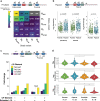Multiplexed characterization of rationally designed promoter architectures deconstructs combinatorial logic for IPTG-inducible systems
- PMID: 33436562
- PMCID: PMC7804116
- DOI: 10.1038/s41467-020-20094-3
Multiplexed characterization of rationally designed promoter architectures deconstructs combinatorial logic for IPTG-inducible systems
Abstract
A crucial step towards engineering biological systems is the ability to precisely tune the genetic response to environmental stimuli. In the case of Escherichia coli inducible promoters, our incomplete understanding of the relationship between sequence composition and gene expression hinders our ability to predictably control transcriptional responses. Here, we profile the expression dynamics of 8269 rationally designed, IPTG-inducible promoters that collectively explore the individual and combinatorial effects of RNA polymerase and LacI repressor binding site strengths. We then fit a statistical mechanics model to measured expression that accurately models gene expression and reveals properties of theoretically optimal inducible promoters. Furthermore, we characterize three alternative promoter architectures and show that repositioning binding sites within promoters influences the types of combinatorial effects observed between promoter elements. In total, this approach enables us to deconstruct relationships between inducible promoter elements and discover practical insights for engineering inducible promoters with desirable characteristics.
Conflict of interest statement
The authors declare no competing interests.
Figures





Similar articles
-
Development of inducer-free expression plasmids based on IPTG-inducible promoters for Bacillus subtilis.Microb Cell Fact. 2017 Jul 25;16(1):130. doi: 10.1186/s12934-017-0747-0. Microb Cell Fact. 2017. PMID: 28743271 Free PMC article.
-
Evaluation of novel inducible promoter/repressor systems for recombinant protein expression in Lactobacillus plantarum.Microb Cell Fact. 2016 Mar 10;15:50. doi: 10.1186/s12934-016-0448-0. Microb Cell Fact. 2016. PMID: 26966093 Free PMC article.
-
Expression of Cloned Genes in E. coli Using IPTG-Inducible Promoters.Cold Spring Harb Protoc. 2021 Feb 1;2021(2). doi: 10.1101/pdb.prot102137. Cold Spring Harb Protoc. 2021. PMID: 33526417
-
Construction of Genetic Logic Gates Based on the T7 RNA Polymerase Expression System in Rhodococcus opacus PD630.ACS Synth Biol. 2019 Aug 16;8(8):1921-1930. doi: 10.1021/acssynbio.9b00213. Epub 2019 Aug 7. ACS Synth Biol. 2019. PMID: 31362487
-
Blending of selected yeast extract and peptone for inducible and constitutive protein production in Escherichia coli using the pET system.J Biosci Bioeng. 2024 Dec;138(6):548-556. doi: 10.1016/j.jbiosc.2024.08.008. Epub 2024 Sep 8. J Biosci Bioeng. 2024. PMID: 39251381
Cited by
-
Small molecule-inducible gene regulatory systems in mammalian cells: progress and design principles.Curr Opin Biotechnol. 2022 Dec;78:102823. doi: 10.1016/j.copbio.2022.102823. Epub 2022 Oct 27. Curr Opin Biotechnol. 2022. PMID: 36332343 Free PMC article. Review.
-
Automated model-predictive design of synthetic promoters to control transcriptional profiles in bacteria.Nat Commun. 2022 Sep 2;13(1):5159. doi: 10.1038/s41467-022-32829-5. Nat Commun. 2022. PMID: 36056029 Free PMC article.
-
Quantitatively Visualizing Bipartite Datasets.Phys Rev X. 2023 Apr-Jun;13(2):021002. doi: 10.1103/physrevx.13.021002. Epub 2023 Apr 4. Phys Rev X. 2023. PMID: 38831998 Free PMC article.
-
E. coli transcription factors regulate promoter activity by a universal, homeostatic mechanism.bioRxiv [Preprint]. 2024 Dec 13:2024.12.09.627516. doi: 10.1101/2024.12.09.627516. bioRxiv. 2024. PMID: 39713321 Free PMC article. Preprint.
-
Design and deep learning of synthetic B-cell-specific promoters.Nucleic Acids Res. 2023 Nov 27;51(21):11967-11979. doi: 10.1093/nar/gkad930. Nucleic Acids Res. 2023. PMID: 37889080 Free PMC article.
References
-
- Binder D, et al. Light-controlled cell factories: employing photocaged isopropyl-β-d-thiogalactopyranoside for light-mediated optimization of lac promoter-based gene expression and (+)-valencene biosynthesis in Corynebacterium glutamicum. Appl. Environ. Microbiol. 2016;82:6141–6149. doi: 10.1128/AEM.01457-16. - DOI - PMC - PubMed
Publication types
MeSH terms
Substances
Grants and funding
LinkOut - more resources
Full Text Sources
Other Literature Sources
Molecular Biology Databases
Research Materials
Miscellaneous

